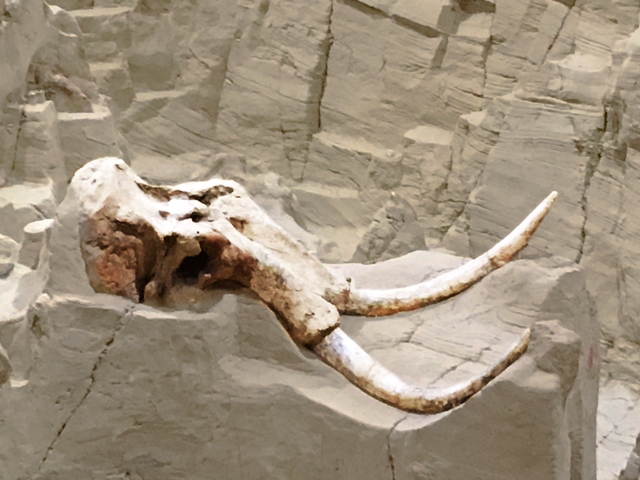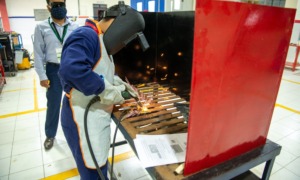
Photos by Stell Simonton
An employee passes the pit at the Mammoth Site of Hot Springs, S.D., where bones of mammoths and other animals of the Pleistocene continue to be excavated.
A resource in South Dakota straight out of the Ice Age has special potential for capturing kids’ imagination and fostering interest in science.
“Look at the bones!” said 7-year-old Adam Bold with awe in his voice. He stood near a large pit holding partly excavated bones of woolly and Columbian mammoths.
Adam was visiting the Mammoth Site in Hot Springs, S.D., earlier this summer with his family from New Hampshire. The site, built around a former waterhole where the bones of many Ice Age animals have been found, is one of the world’s largest sites exhibiting remains of mammoths who died there.
More than 140,000 years ago a sinkhole formed and filled with water from a hot spring. Lush vegetation lured many young mammoths to the waterhole, but they were unable to climb out due to its steep, slippery sides. Their bones are preserved in positions showing their struggle to get out.
It’s a tourist destination, an ongoing excavation, a research lab and an education site.
And it’s beefing up its offerings for kids under the new direction of paleontologist and science educator Sharon Holte.
Visitors can see the excavation pit, view exhibits, buy books and trinkets and look through a laboratory window to see microfossils being sorted.
At one exhibit, Adam’s sister Abigail Bold, 10, measured her arm against a replica of a mammoth ulna, or forearm bone.
“I like how you can actually walk around the pit,” she said.

A mammoth skull lies in the pit where it was discovered. Most of the mammoths that were trapped in the sinkhole 26,000 years ago were young males, researchers believe.
For visitors, the site offers a 30-minute guided tour. In addition, kids can take a half-hour excavation class. Older kids and adults can take a two-hour excavation class.
The Mammoth Site also provides curricular materials, including “Mammoth in a Trunk” kits for use by educators.
One kit for fourth graders allows them to build a sinkhole in a glass in order to learn how sinkholes form. Younger kids might learn about erosion by creating a sediment bed. Another kit teaches about projectile points that humans used to kill game. The materials for middle and high school students teach osteology, the science of bones, which provides much information about an animal from its skeleton — particularly jaws and teeth.
The education materials are being updated to match Next Generation Science Standards, Holte said.
“We are looking at developing some summer programs in the future,” Holte said.
The Mammoth Site also uses college and some high school interns to lead tours, teach kids and do research.
The nonprofit organization is funded by memberships, donations, tourism and grants from corporate and family foundations.
“It’s a venerable American tradition, this mix of science, show business and big hairy pachyderms,” according to a 2010 article at smithsonian.com.
As STEM (science, technology, engineering and medicine) programs across the country seek to engage kids and increase the pool of future scientists, organizations like the Mammoth Site have many ingredients that could be used to play an important role.
This story has been updated.































